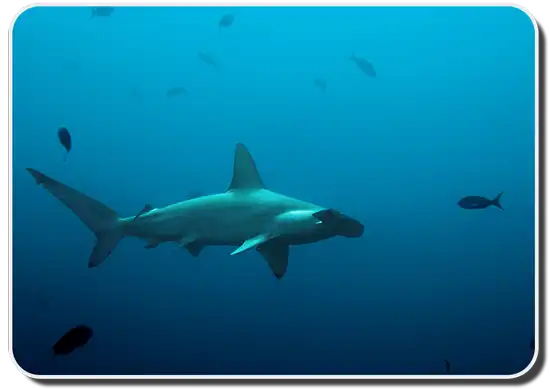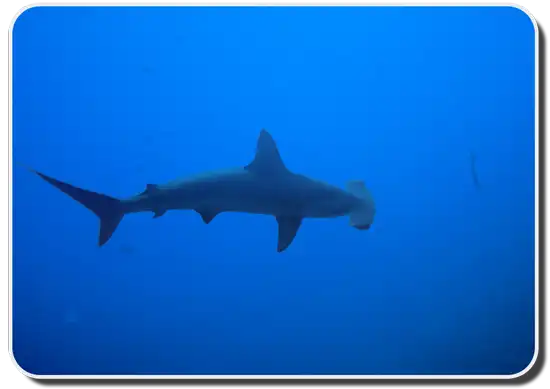Ah yes, the Hammerhead Shark. Take one look at this amazing fish and you’ll know how it got its name. The scientific name for its hammerhead shaped head is called Cephalofil.
Found far off shore in warm tropical waters throughout the world, there is one shark that sets itself apart from other shark species in more ways than one – especially in appearances: The Hammerhead Shark. Due to their ability to survive in sandy plains, kelp forests, fresh as well as ocean waters, and intertidal waters, they get around quite easily and you can catch a glimpse of them almost anywhere.

The Hammerhead Shark, also known as Sphyrnidae, is one of the most recognizable shark species out there due to its wide, flat, T-shaped head and wide-set eyes. They use their oddly-shaped heads to improve their ability to find prey; their wide-set eyes provide superior visual range to most other sharks, and they have highly specialized sensory organs spanning across their heads, so they are able to more thoroughly scan the ocean for their food.
Though they have a more mellow temperament than other sharks, the Hammerhead takes hunting for food very seriously, and can locate food more easily due to their increased sense of smell. Their diet consists of small fish, squid, sting rays, crabs, and even other small sharks.
Why The Strange Head?
As mentioned above, sting rays are prey for the Hammerhead, and happen to be this shark’s favorite meal. Because sting rays are completely flat and therefore easily able to camouflage themselves on the ocean floor, Hammerheads need to be able to easily capture them. This is where the shape of their head comes in.
The skin of a shark is very unique in that it is covered in a tooth like structure called dermal denticles, and Hammerhead Sharks are no exception. Of all the facts about Hammerhead Sharks we’ll be going over, this one is one of the coolest – Hammerheads have ridges on the crowns of their dermal denticles which help lead scented water to its nares, or nostrils, that helps them easily smell their prey. Pair this with their sensory organs to pick up on a sting ray’s electrical pulses, and you’ve got the perfect predator for a sting ray. They use these advantages to swim directly above the ocean floor, swaying its head side to side like a sting ray metal detector. Sting rays beware!
Different Species of Hammerheads
- Winghead Shark – The Winghead is distinguished from other species of Hammerhead by its especially long and slender head lobes, and relatively small frame averaging only at around 4 feet. They are typically grey or light brown in color, with a light underside.
- Bonnethead & Scalloped Bonnethead – are significantly smaller ranging at 2 to 5 feet long on average, with the females growing a bit larger than the males. They are greyish-brown in appearance with dark spots and a white belly, and need to swim continuously to provide fresh oxygen to their gills.
- Whitefin Hammerhead – The Whitefin is similar in appearance to the Scalloped Hammerhead, but has a more narrow-bladed, broad head and on average reach a length of 9 feet.
- Scalloped Hammerhead – This Hammerhead Shark is another species in our journey through facts about Hammerhead Sharks, and is one of the most commonly found species in coastal regions. They are typically olive, bronze or light brown in color with a white belly, and on average reach a length of 13 feet.
- Great Hammerhead – First, there’s the Great Hammerhead Shark, which is by far the largest species with the largest recorded length reaching 20 feet long – that’s as big as George Washington’s nose on Mount Rushmore! Though a 20-foot Great Hammerhead has been found, the average Great Hammerhead is only about 11 feet long, and the females tend to be larger than the males, though the males mature a bit earlier.
- Smalleye Hammerhead – The Smalleye Hammerhead is much smaller than its other Hammerhead counterparts, with the average length of this species reaching only about 5 feet. They have a broad and arched head that’s shaped a bit like a mallet, characterized by a deep indentation at its center.
- Smooth Hammerhead – which can be distinguished by a single notch in the center of its head. This species has a tall, sickle shaped dorsal fin and plain pectoral fins tipped with black, and measure anywhere from 8 to 11 feet long on average.

Hammerheads Lifespan
The lifespan for most Hammerheads is between 25 and 35 years. It’s likely that over time, they are beginning to live longer lives. The reason for this is currently unknown.
The eyes of this shark are placed on the outer edges of the hammer. This allows them a vertical 360 degree view, which means the Hammer head shark is able to see both above and below quite easily. Unfortunately, this eye placement causes a huge blind spot directly in front of their nose!
This fish is well known for its ability to make very sudden and sharp turns. Not only does the hammer at as an organ of balance, but its body seems to be specifically designed to twist and bend.
Believe it or not, the Hammerhead has the ability to sport a nice tan! They are one of very few animals who tan from the sun. This happens to the shark because Hammerheads are often cruising in shallow water or near the surface for extended periods of time.
Habitat
Hammerhead Sharks love tropical, warm waters from all over the world. They mostly stay along continental shelves and coastlines, but on occasion they are found in the deep ocean cruising near the surface.
Hammerhead Shark Habitat Map

Sensory System
As with all other shark species, Hammerhead Sharks have a special sense of feeling using electro receptors. This an organ called the ampullae of Lorenzini. Sharks are able to pick up very small electrical pulses that all living things emit. In fact, they can sense the beating heart of a human from several miles away!
Hammerhead Shark Teeth
One of the other amazing facts about Hammerhead Sharks is their chompers. In order to have the diet that they have, Hammerhead Sharks need to have some strong and specially designed teeth. Hammerhead Shark teeth have smooth edges, with a distinct notch on the distal side of the tooth. These teeth also have a deep nutrient groove. In regards to their size, Hammerhead teeth usually range between 1/4 to 3/4 of an inch in length.

Social Life
For the most part, these sharks are mavericks, thinking and acting for themselves and by themselves. This is especially true for Great Hammerheads. But Scalloped Hammerheads are often observed building large schools of 100 or more individuals. It is believe that these schools are largely for protection from the opposite sex. Females will be bombarded with males when left alone. But when swimming with others, the females can select what males are allowed nearby and what males aren’t. This phenomenon draws some tourism from shark enthusiasts, especially at the Great Barrier Reef or Galapagos Island.
Hunting Behavior
These sharks are hunters of the night. Compared to other predators, they have very small mouths. Because of this shortfall, many become bottom hunters with a preferred prey of rays, shrimps, squids, small fish, and even other shark species. The Great Hammerhead is feared by smaller Hammerhead species due to frequent cannibalism.
But what makes this shark so unique is its head, right? The head acts as a sort of “metal detector” as it travels over the Ocean floor. Since much of its pray hides beneath the sandy floor, the Hammerhead traces the sea bed and “scans” for living creatures it can eat.
Offspring
Hammerhead Sharks are Viviparous, which means pups grow inside the female shark, similar to humans. Unlike humans, the mother gives birth to 20 to 50 live pups at once. The reproductive process is still quite a mystery in the scientific communities. Studies are currently ongoing to learn more about this amazing animal.
Relationship with Humans
Unfortunately, many species of Hammerhead Sharks are at a high risk of extinction. Hammerhead fins are considered a delicacy in many countries. Fisherman can sell these fins for very high prices, so many times a Hammerhead is captures, has its fins removed, then is dumped back into the Ocean. Of course, without fins, the shark is unable to swim and subsequently dies. Humans are the #1 threat to all species of Hammerhead Sharks.
Attacks on humans are extremely rare. Only 3 of the 9 Hammerhead species (Great, Scalloped, and Smooth Hammerheads) have ever attacked a human. The vast majority of the time, these sharks are safe for divers in open waters. Like Reef Sharks, they give warning signals before attacking, such as a series of wild contortions. Trained divers know these signs and how to deal with an agitated Hammerhead Shark.
